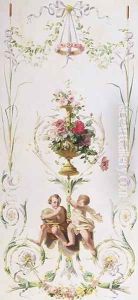(circle of) Andien de Clermont Paintings
Andien de Clermont is a painter whose name might not immediately ring bells for those not deeply versed in the intricacies of 18th-century European art, yet his contributions, particularly in the realm of trompe-l'oeil and decorative painting, hold a special place in the art historical canon. Born in 1676, de Clermont's life and career spanned a period of significant change in European art, witnessing the tail end of the Baroque period and the rise of Rococo, with its lighter themes and more playful approach to art and decoration.
De Clermont was of French origin but spent a significant portion of his professional life in England, where he was known particularly for his work in stately homes and for private patrons. His work often involved creating decorative paintings and trompe-l'oeil effects, which are visual illusions in art, created to trick the eye into perceiving painted detail as a three-dimensional object. This technique was highly prized in the decoration of lavish interiors of the time, and de Clermont's skill in this area made him a sought-after artist among the British elite.
Though specifics about his training are somewhat obscure, it is believed that Andien de Clermont was trained in the French painting tradition, which is evident in the sophistication of his technique and the influence of French artistic styles in his work. His transition to England and the adaptation of his French aesthetic to suit the tastes of his British patrons is a fascinating study in the cross-pollination of artistic ideas and styles across national boundaries in the 18th century.
De Clermont's legacy, while perhaps not as widely recognized as some of his contemporaries, is significant in the realm of decorative arts. His works not only adorned the homes of the wealthy but also contributed to the broader dialogue of European art, bringing French elegance and the illusionistic playfulness of trompe-l'oeil into the English context. His death around 1753 marked the end of an era that bridged the Baroque and Rococo periods, and his body of work remains a testament to the skill and creativity of decorative painters of the 18th century.
